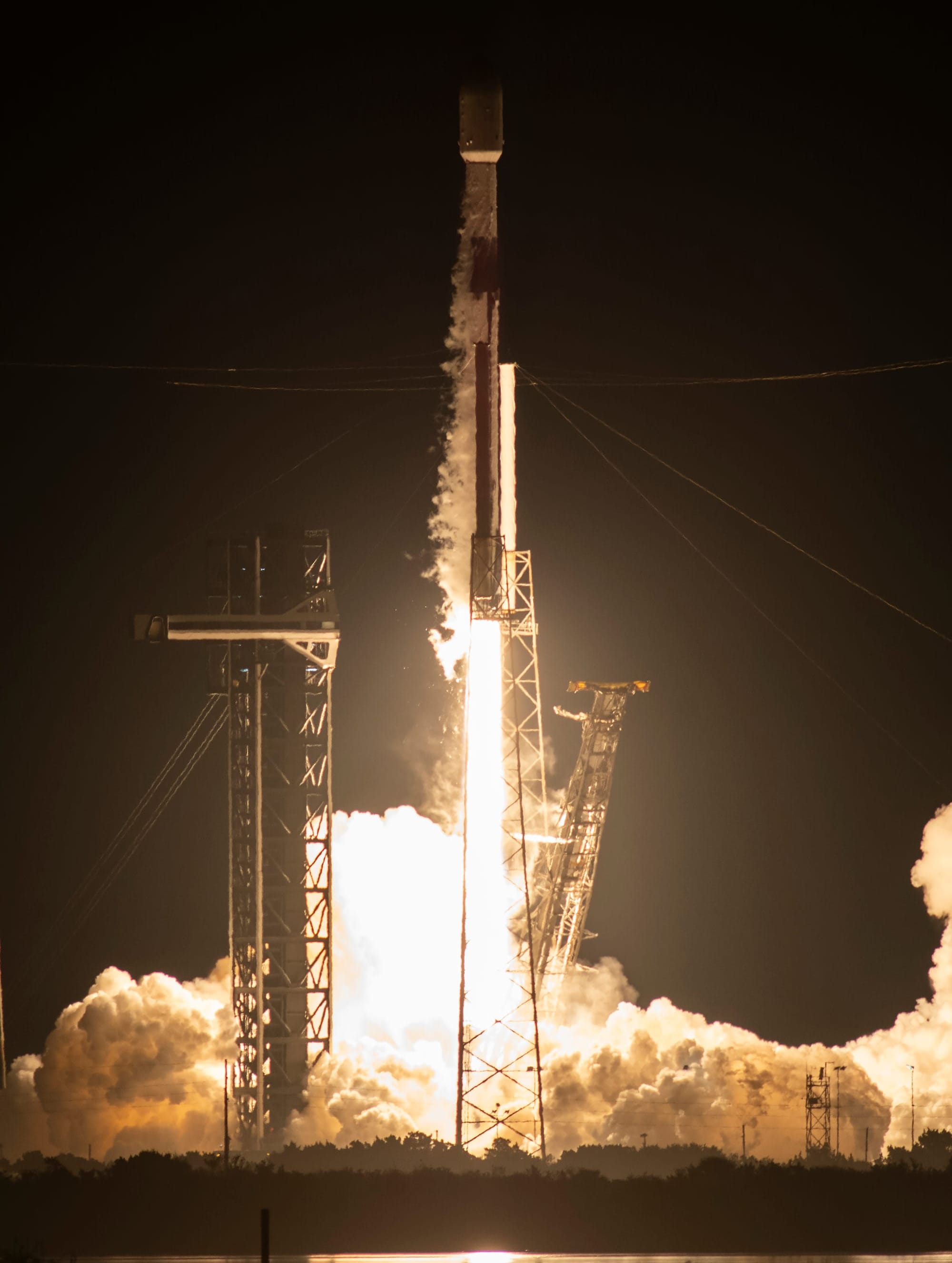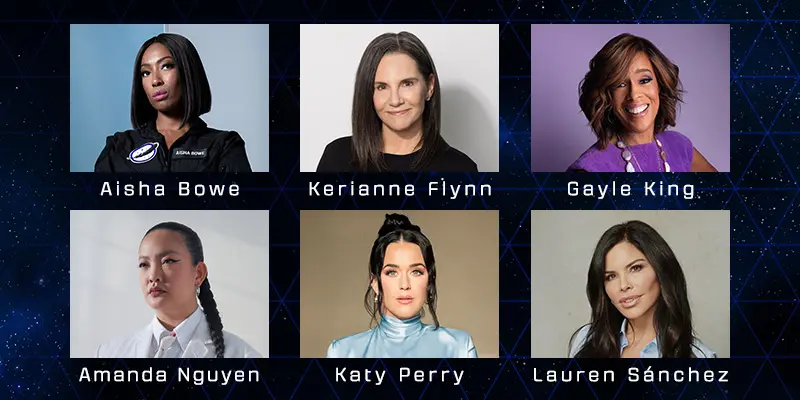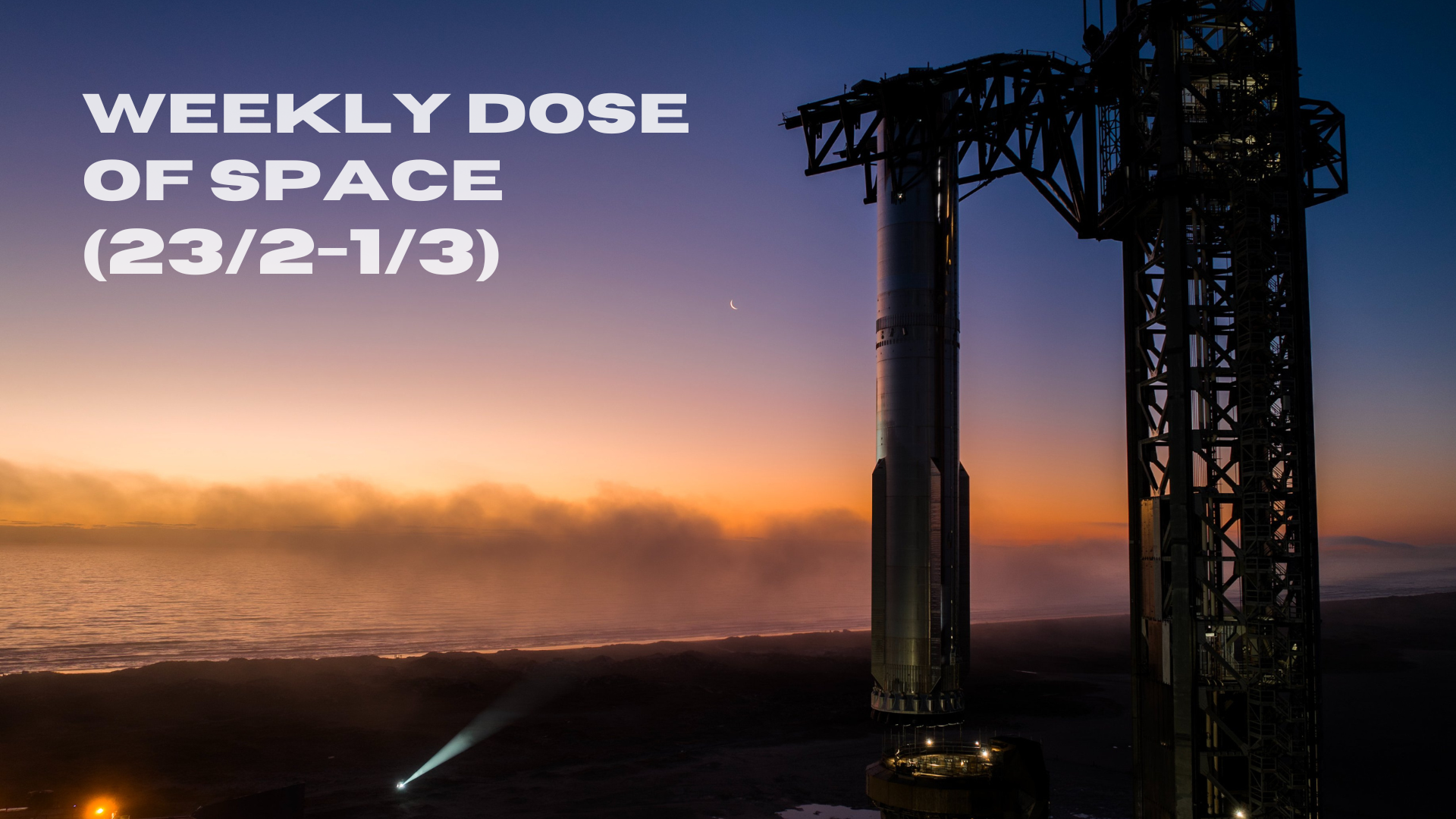Table of Contents
Welcome back to Weekly Dose of Space! This week once again saw five launches taking place, with missions heading out toward the Moon and deep space. News from the week had Pakistan planning to fly to China's space station, Virgin Galactic set to begin work on new spaceplanes, and Blue Origin announcing the crew of the NS-31 mission. As always, we'll also look ahead to what the worldwide launch schedule might look like next week.
Launches This Week
February 25th - New Shepard for NS-30
Blue Origin launched New Shepard's tenth crewed mission from the company's West Texas launch site. Onboard New Shepard were passengers Lane Bess, Jesús Calleja, Elaine Chia Hyde, Dr. Richard Scott, Tushar Shah, and an undisclosed sixth individual.
Making memories above the Kármán line. pic.twitter.com/o7JbVnBoWq
— Blue Origin (@blueorigin) February 26, 2025
Blue Origin's recap of the NS-30 mission, via Blue Origin on Twitter.
February 27th - 27th - Falcon 9 with Nova-C IM-2 and other payloads
A Falcon 9 lifted off from Launch Complex 39A carrying Intuitive Machines' second Nova-C lander for the IM-2 mission, NASA's Lunar Trailblazer satellite, and an unknown commercial satellite to a lunar transfer orbit, more details on the payloads are available here. The booster supporting this mission was B1083, making its ninth flight and landing downrange on the drone ship 'A Shortfall Of Gravitas'.

February 27th - Falcon 9 with Starlink Group 12-13
Twenty-one more Starlink satellites were launched to low Earth orbit atop of a Falcon 9 flying from Space Launch Complex 40. The booster that supported this mission may have been B1092, flying for the first time and landing on the drone ship 'Just Read The Instructions' downrange.

February 27th - Long March 2C with SuperView Neo-1 03 & 04
A Long March 2C lifted off from Launch Area 4 at the Jiuquan Satellite Launch Center carrying two satellites to sun-synchronous orbit. The two satellites were the SuperView Neo-1 03 and 04 commercial remote sensing satellites.

February 27th - Soyuz 2.1a with Progres MS-30
A Soyuz 2.1a flying from the Baikonur Cosmodrome launched the Progress MS-30 spacecraft into low Earth orbit where it began its journey to the International Space Station.
March 1st - Kuaizhou-1A with an unknown payload
ExPace attempted to launch its Kuaizhou-1A vehicle from the Jiuquan Satellite Launch Center. This launch is believed to have failed very early into flight.
In Other Space News
All woman NS-31 crew to include Katy Perry

On February 27th, Blue Origin announced who would be flying on the NS-31 mission, the company's eleventh crewed New Shepard flight. The names and some details (courtesy of Blue Origin) about the crew are as follows:
Katy Perry is the biggest-selling female artist in Capitol Records’ history and one of the best-selling music artists of all time with over 115 billion streams. Aside from being a global pop superstar, Katy is an active advocate of many philanthropic causes, including as a UNICEF Goodwill Ambassador where she uses her powerful voice to ensure every child’s right to health, education, equality, and protection, and her own Firework Foundation, which empowers children from underserved communities by igniting their inner light through the arts.
Gayle King is an award-winning journalist, co-host of CBS Mornings, editor-at-large of Oprah Daily, and the host of Gayle King in the House on SiriusXM radio. In a career spanning decades, King has been recognized as a gifted, compassionate interviewer able to break through the noise and create meaningful conversations.
Aisha Bowe is a former NASA rocket scientist, entrepreneur, and global STEM advocate. She is the CEO of STEMBoard, an engineering firm recognized twice on the Inc. 5000 list of America’s fastest-growing private companies, and the founder of LINGO, an edtech company on a mission to equip one million students with essential tech skills.
Amanda Nguyen is a bioastronautics research scientist. She graduated from Harvard, and conducted research at Harvard Center for Astrophysics, MIT, NASA, and International Institute for Astronautical Sciences. Amanda worked on the last NASA shuttle mission, STS-135, and the Kepler exoplanet mission. For her advocacy for sexual violence survivors, she was nominated for the Nobel Peace Prize and awarded TIME’s Woman of the Year.
Kerianne Flynn has spent the last decade, following a successful career in fashion and human resources, channeling her energy into community-building through board service and nonprofit work with The Allen-Stevenson School, The High Line, and Hudson River Park. Passionate about the transformative power of storytelling, Kerianne has produced thought-provoking films such as This Changes Everything (2018), which explores the history of women in Hollywood, and LILLY (2024), a powerful tribute to fair-pay advocate Lilly Ledbetter.
Lauren Sánchez is an Emmy Award-winning journalist, New York Times bestselling author, pilot, Vice Chair of the Bezos Earth Fund, and mother of three. In 2016, Sánchez, a licensed helicopter pilot, founded Black Ops Aviation, the first female-owned and operated aerial film and production company. Sánchez released her New York Times bestselling debut children's book, The Fly Who Flew to Space, in 2024. Her work in aviation earned her the Elling Halvorson Vertical Flight Hall of Fame Award in 2024 for her expertise as a helicopter pilot and aviation businesswoman.
The six women will be part of the first all-female mission above the Kármán line since the flight of Valentina Tereshkova in June 1963. New Shepard is currently set to perform the NS-31 mission in the Spring of this year.
Pakistan to fly to China's Tiangong Space Station
The China Manned Space Agency and Pakistan's Space and Upper Atmosphere Research Commission announced on February 28th that the two space agencies had signed an agreement to fly a Pakistani astronaut to the Tiangong Space Station. Part of the announcement from the Chinese side states:
“According to the plan, the two sides will use about a year to complete the selection work, and Pakistani astronauts will receive comprehensive and systematic training in China. According to the flight mission planning arrangement of the Chinese space station, Pakistani astronauts will be arranged to enter the Chinese space station with Chinese astronauts to perform short-term flight missions in the next few years.”
The two space agencies have not yet provided a timeline for when a Pakistani astronaut will fly to Tiangong. However, with around a year needed for selection, followed by training, a mission carrying Pakistan's astronaut may occur in late 2026 or 2027. Additionally, this astronaut is expected to fly for a short-duration mission, possibly only being onboard during a crew handover period.
For China, flying a Pakistani astronaut will likely allow the country to develop a solid framework for future missions with more international astronauts, both to Tiangong and the Moon.
Virgin Galactic to begin work on new spaceplane
Executives at Virgin Galactic announced in an earnings call on February 26th that it would start work on assembling its first next generation spaceplanes, expected to fly in mid-2026. As part of the call, Virgin Galactic's Chief Executive Officer, Michael Colglazier stated:
“The production and launch timeline for the new [Delta] ships remains on track, with our first commercial research spaceflight expected in the summer of 2026, and the first private astronaut spaceflight in the fall of 2026,” – “We are able to be more specific with projecting our timelines because we now have line of sight to the delivery dates of each and every tool and part that supports assembly.”
Last year the company retired its Unity line of spaceplanes to develop the improved Delta spaceplanes. Once flying next year, the Delta spaceplanes are intended to bring Virgin Galactic to profitability. When pushed about development, Mike Moses, Virgin Galactic's spaceline president, added:
“Unity required moving in small incremental steps to build up the knowledge about the spaceship’s performance and limits,” – “The test flights of Delta will be much more like regression testing, where we are incrementally expanding how Delta flies, but doing so by comparing it to how we know Unity flew.”
Virgin Galactic expects the Delta spaceplanes to quickly pass through testing to meet its mid-2026 target.
What to Expect Next Week
March 2nd - Soyuz 2.1b with Glonnass-K2
A Soyuz 2.1b may liftoff from the Plesetsk Cosmodrome carrying a Glonass-K2 satellite to medium Earth orbit.
March 3rd - Falcon 9 with Starlink Group 12-20
Another batch of Starlink satellites are expected to launch atop of a Falcon 9 flying from Space Launch Complex 40.
March 3rd - Ariane 6 with Composante Spatiale Optique-3
An Ariane 6 is expected to fly into sun-synchronous orbit from the Guiana Space Center carrying the Composante Spatiale Optique-3 optical imaging satellite for the French military.
March 3rd - Starship-Super Heavy for its eighth flight test
SpaceX could be attempting Starship-Super Heavy's eighth flight test on February 26th utilizing Ship 34 and Booster 15.
March 5th - Falcon 9 with SPHEREx and PUNCH
A Falcon 9 is planned to launch from Space Launch Complex 4E into a polar orbit carrying NASA's SPHEREx (Spectro-Photometer for the History of the Universe, Epoch of Reionization, and Ices Explorer) and PUNCH (Polarimeter to Unify the Corona and Heliosphere) spacecraft.
March 5th - Falcon 9 with Starlink Group 12-21
Yet another batch of Starlink satellites may launch from Space Launch Complex 40 atop of a Falcon 9.
March 6th - Falcon 9 with Transporter-13
A Falcon 9 is planned to launch SpaceX's thirteenth dedicated Transporter rideshare mission from Space Launch Complex 4E.
March 7th - Falcon 9 with Starlink Group 12-16
Even more Starlink satellites may launch from Space Launch Complex 40 atop of a Falcon 9.
March 8th - Falcon 9 with Starlink Group 11-7
And yet more Starlink satellites may launch from Space Launch Complex 4E atop of a Falcon 9.







